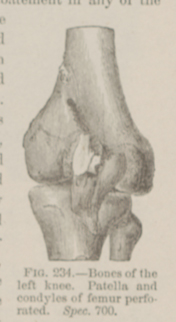Title: Sarvis, I. N.
Source text: The Medical and Surgical History of the War of the Rebellion. (1861-65.), Part 3, Volume 2 (Washington, DC: Government Printing Office, 1883), 380-381.
Civil War Washington ID: med.d2e15706
TEI/XML: med.d2e15706.xml
CASE 571.—Private I. N. Sarvis, Co. C, 131st Pennsylvania, was wounded at Fredericksburg, December 13, 1862, and was admitted to Mount Pleasant Hospital, Washington, four days afterwards. Acting Assistant Surgeon J. C. Wyer forwarded the pathological specimen (FIG. 234) and reported the following detailed history: "Sarvis received his wound by a ball perforating the patella of the left leg, passing through the knee and making its exit at a point nearly opposite in the popliteal space. When admitted his whole constitution was suffering from the effects of the injury; the pulse quick and frequent, denoting irritability; the skin dry and hot; appetite poor; sensibility of the joint extreme, the patient shrieking on account of the pain occasioned by the slightest motion of the limb. The discharge from the wound consisted of synovia and thin unhealthy pus. There was nothing peculiar about the aspect of the limb except a general tumefaction. The tongue was furred lightly, and the expression anxious; bowels constipated. On the tenth day after admission he was attacked with a severe chill, which was followed by fever, and from this period the hectic flush began to appear upon the cheeks periodically. Subsequently there were recurrences of the rigors. Occasionally the mind wanders. The features are pinched, the skin is sallow, and countenance exhibits the icteroid appearance always present in pyæmia. There is great thirst, and the respiration is quick and irregular. On December 28th, he was attacked with a cough, the expectoration being tough, gelatinous, and streaked with blood. Auscultation revealed crepitant and sibilant rales through both lungs. On the 5th of January, 1863, Surgeon J. H. Brinton, U. S. V., visited the hospital and his attention was called to the case. At this period the case was one of well-marked pyæmia; the lung complication Dr. Brinton pronounced as multiple or metastatic abscess. 6th, no abatement in any of the symptoms. 7th, rales and rhonchi still audible through the lungs; pulse continues 120 beats in the minute; skin dry and hot; tongue dry and fissured; appetite much impaired; patient lies drowsy and dull most of the time. The discharge from the knee is profuse, ichorous, and of a sickening odor. From the 8th to 13th the symptoms have continued the same: respiration quick, pulse 130; tongue dry and crusty; discharge from the knee ichorous and extremely offensive; expectoration rusty and gelatinous. Has had slight rigors. Rales and rhonchi still present. Complains of pain on the least motion of his body. Urine scanty and turbid; bowels constipated; loss of appetite. Continues in a semi-comatose, dull condition. 14th: This morning he is unable to protrude his tongue; the features are pinched and sunken; pulse very feeble and rapid; deep hectic flush. Evening: has been moaning all day and refused his stimulants. The peculiar odor is very evident. Died at 4.30 A. M. on January 15, 1863. Autopsy eight hours after death: Rigor mortis was still present; emaciation extreme. The thorax being laid open revealed the superior lobes of the lungs apparently healthy, but upon removing them the inferior lobes were found to be consolidated and studded with abscesses varying in size from a pea to larger ones, the diameter of which measured about half an inch. The consolidation and effusion extended also to the dependent portions of the superior lobes. There was considerable effusion in the left pleural cavity. The heart was perfectly normal; no deposit upon the valves. A small clot was discovered in the right ventricle; there was also some of the separated fibrin; no effusion in the pericardium. The inferior lobes of both lungs sank readily in water. On making the incision to resect the knee joint, pus escaped from beneath the muscles of the lower third of the thigh. There was a good deal of disintegration of the tissues. The extremities of the femur and tibia were entirely separated, the crucial ligaments having been destroyed by the ball in its passage through the joint and the capsule ulcerated through at several points. The patella was perforated about its centre, dividing it into several fragments, which, however, were retained in position by the ligamentum patellæ. The internal condyle of the femur was crumbled into small fragments, and a deep furrow marked the course of the ball." In addition Dr. Wyer remarks that "at no period since his admission has an operation been admissible," also that the patient had likewise a wound of the right shoulder, involving the joint. The specimen consists of the bones of the injured knee.
